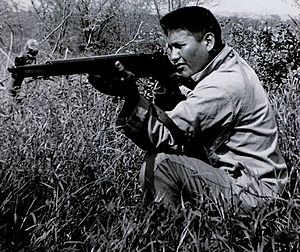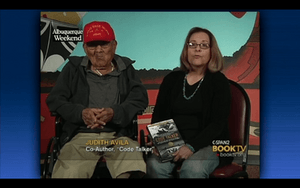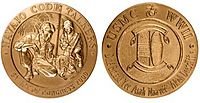Chester Nez facts for kids
Quick facts for kids
Chester Nez
|
|
|---|---|

Chester Nez during World War II
|
|
| Born | January 23, 1921 Chi Chil Tah, New Mexico, U.S.
|
| Died | June 4, 2014 (aged 93) Albuquerque, New Mexico, U.S.
|
| Alma mater | University of Kansas |
| Known for | Being the last survivor of the original twenty-nine Navajo Code Talkers from World War II |
| Awards | Congressional Gold Medal |
Chester Nez (born January 23, 1921 – died June 4, 2014) was an American hero. He was a veteran of World War II. He was also the very last of the original 29 Navajo code talkers. These brave men served in the United States Marine Corps during the war.
Contents
Growing Up
Chester Nez was born in Chi Chil Tah, New Mexico. He belonged to the Navajo Dibéłizhiní (Black Sheep Clan) and the Tsénahabiłnii (Sleeping Rock People). When he was young, the U.S. government and the Navajo Nation had a difficult relationship.
Chester's mother passed away when he was only three years old. He remembered that children were often taken from their homes. They were sent to special boarding schools. At these schools, they were not allowed to speak their native Navajo language.
When Chester was eight, he went to a school run by the Bureau of Indian Affairs. This is where he was given his English name, Chester. It was named after a U.S. president. Later, he was recruited into the Marine Corps from one of these schools in Tuba City, Arizona.
The Code Talker Mission
Chester Nez decided to join the Marines without telling his family first. He and 28 other Navajo men became part of Recruit Training Platoon 382. This happened at Marine Corps Base San Diego in May 1942.
After finishing their basic training, these 29 men, including Chester, had a very important job. They were sent to Camp Elliot, California. Their mission was to create a secret code. This code would be used for secure voice messages during battles. At that time, enemies could easily listen to radio talks. This often led to big problems.
The Navajo language was chosen for the code. It was very hard to learn if you didn't already speak it. It also had no written form. Chester Nez said they used everyday Navajo words for the code. This made it easier to remember.
In 1942, Chester was sent to Guadalcanal. There, code talkers worked in teams of two. One person would send and receive messages. The other would operate the radio and check for mistakes. Chester also fought in battles in Bougainville, Guam, Angaur, and Peleliu. He was honorably discharged from the Marines in 1945. He later served in the Korean War and left the service as a corporal.
Life After the Military
After his military service, Chester Nez went to the University of Kansas. From 1946 to 1952, he studied commercial arts. He had to stop his studies when his funding ran out. However, in 2012, the University of Kansas gave him an honorary bachelor's degree. This was a special award for his service.
For 25 years, Chester worked as a painter. He worked at a V.A. hospital in Albuquerque. In 2011, he wrote a book about his experiences. It was called Code Talker: The First and Only Memoir by One of the Original Navajo Code Talkers of WWII. He wrote it with Judith Avila.
A Special Honor: The Congressional Gold Medal
On July 26, 2001, Chester Nez received a very high honor. He was one of five living code talkers to get the Congressional Gold Medal. President George W. Bush presented this award.
President Bush spoke about the code talkers:
Today, we marked a moment of shared history and shared victory. We recall a story that all Americans can celebrate and every American should know. It is a story of ancient people called to serve in a modern war. It is a story of one unbreakable oral code of the Second World War, messages travelling by field radio on Iwo Jima in the very language heard across the Colorado plateau centuries ago. – President George W. Bush.
His Final Years
Chester Nez passed away on June 4, 2014. He was 93 years old. He died in Albuquerque from kidney failure.



